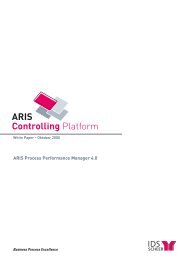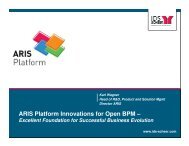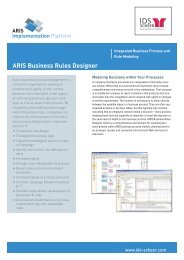From Business Process Design to Enterprise ... - IDS Scheer AG
From Business Process Design to Enterprise ... - IDS Scheer AG
From Business Process Design to Enterprise ... - IDS Scheer AG
Create successful ePaper yourself
Turn your PDF publications into a flip-book with our unique Google optimized e-Paper software.
ARIS Expert Paper<br />
2.3 System description<br />
Access diagrams are used <strong>to</strong> describe systems at<br />
type level (fig. 10). The type level (often also called<br />
the “logical view”) contains information about the<br />
underlying operating system, programming language,<br />
database, hardware type, organization<br />
responsible, and person responsible for the application.<br />
Parts of this system description can be<br />
imported from a configuration ma na ge ment database<br />
(CMDB). Keeping this information up <strong>to</strong> date is<br />
the task of the person responsible for the application.<br />
Fig. 11: Navigation and analysis functions<br />
The interfaces between a system and other systems<br />
are shown in figure 12. Information about the data<br />
exchanged, pro<strong>to</strong>cols used, etc., can also be s<strong>to</strong>red<br />
here.<br />
Here again, this view enables the impact of system<br />
and interface changes <strong>to</strong> be analyzed.<br />
8<br />
Fig. 10: System description<br />
Navigation and analysis functions (fig. 11) are used<br />
for such purposes as identifying the systems that<br />
feature specific technologies. This makes it possible<br />
<strong>to</strong> analyze the impact of a change of technology,<br />
provider, or version, and <strong>to</strong> inform/involve the relevant<br />
persons.<br />
Fig. 12: Interface diagram

















